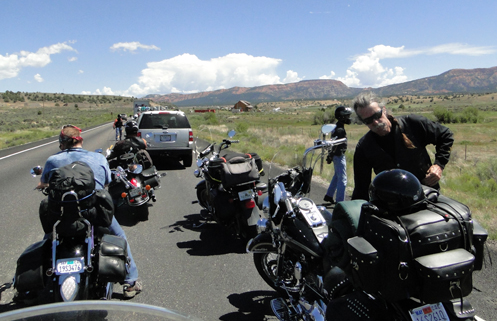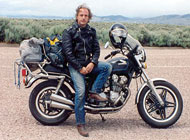HOV And Transponder Talking Points

This would be a potential opportunity for lane-splitting, as these bikes could move up to the front and get off ahead of the cars once traffic starts moving again.
Stump is the Legislative Affairs Officer for ABATE of Colorado and he has been working with the state to ensure that motorcyclists are treated appropriately–in regard to federal law–when it comes to this whole thing with HOV lanes and the requirement to have a transponder on the bike.
Stump can’t do it all. The more people who speak to their elected state officials the more they will pay attention. Here are 10 talking points Stump has put together that sum up the argument pretty well. If you have the opportunity to say anything to your state rep–or if you choose to do so on your own initiative–these are the kinds of things you might want to say to them. (I’ve tweaked a couple for grammar and clarity.)
1. Motorcycles are considered a high-occupancy vehicle (HOV) under all conditions per 23 USC 166 (b) (2) (A).
2. Federal funds were used to build the HOV/HOT lanes, qualifying the use of motorcycles as an HOV per #1 above.
3. Adding a requirement/restriction for motorcycles to use an HOV lane is not necessary for the federal law to apply.
4. Charging a motorcycle to use an HOV lane if it doesn’t have a transponder and not charging if they do is a double standard and restricts/prohibits/fines motorcycles for using a lane they are entitled to used under federal law.
5. The requirement of a “deposit” for a transponder is a collection of monies from motorcyclists by a governmental entity without the consent of the people being assessed.
6. HOV/HOT lanes are not both “toll roads” and must be considered to be two separate types of roadways.
7. HOV lanes were originally implemented to help relieve congestion, save fuel, address parking issues, etc. and provide a means for those who combined/shared vehicles to benefit from their actions. HOT lanes allow anyone who will pay a fee to receive an advantage based on money, not the original intent of the lane.
8. The Colorado Department of Transportation has stated that it is safer for a motorcycle in an HOV lane and the chance of a crash or injury is reduced, as compared to using a congested lane.
9. Requiring a transponder on a motorcycle requires those who only use the lane once or twice a year because of where they live in the state, or those motorcyclists from out of state who are unaware that a transponder is required, to pay a fine/fee to use a lane that is safer and, in the majority of states, is free.
10. Even if a picture is taken of a motorcycle and license plate, it would take only seconds to identify the vehicle as a motorcycle, discard it, and move on.
So OK, the second sentence in #7, in particular, is still a little murky to me, but in general I’d say this is good information. So if you have a chance to communicate with the people who represent you in the legislature, you’ll be doing us all a favor to bring out these points.
Biker Quote for Today
Is your motorcycle a 2 cylinder or 4 stroke?
Tags: HOV lanes

January 28th, 2016 at 10:19 am
[…] rejoin the discussion of motorcycles needing transponders to use HOV lanes without paying a […]